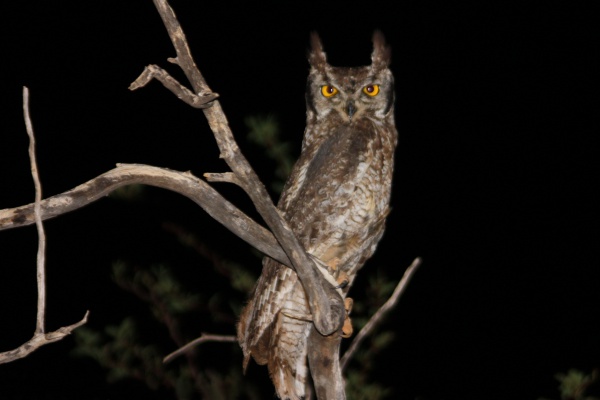Facts About Spotted eagle-owl
The spotted eagle-owl, also known as the African spotted eagle-owl or African eagle-owl, is a remarkable medium-sized bird of prey. It measures around 45 centimeters in length and typically weighs between 454 and 907 grams. Its wingspan, which ranges from 100 to 140 centimeters, is an impressive sight to behold. This owl is easily recognizable by its off-white to pale ochre facial disk, vivid yellow eyes, prominent ear tufts, dusky brown upper body, and off-white lower parts adorned with brown barring. Initially thought to be the same species as the greyish eagle-owl, it is now acknowledged as a distinct species.
The spotted eagle-owl has a diverse diet, primarily consuming rodents, small mammals, birds, insects, and reptiles. Interestingly, it swallows prey whole and later regurgitates indigestible parts such as feathers and bones in the form of pellets. This adaptable bird relocates its hunting grounds based on prey availability and is known for its aggressive territorial defense, communicating through distinctive hoots and calls.
Regarding conservation, the spotted eagle-owl is commonly found in Southern Africa, often near human settlements. In South Africa, it is illegal to capture or keep these owls without appropriate permits. Unfortunately, they face various threats, including collisions with cars, electrocution by power lines, persecution, poisoning, and parasite infections.
Spotted eagle-owls are monogamous and breed from July to February, laying 2 to 4 eggs that are primarily incubated by the female. The owlets leave the nest at about five weeks old and spend some time on the ground before they can fly. During this critical period, they are supported by their parents. By around seven weeks old, the owlets achieve full flight capability. In the wild, these owls can live up to 10 years, while in captivity, they can reach up to 20 years. Specialized release methods are employed to reintegrate captive-raised owlets into the wild, ensuring their survival and continued presence in their natural habitat.

 South Africa
South Africa